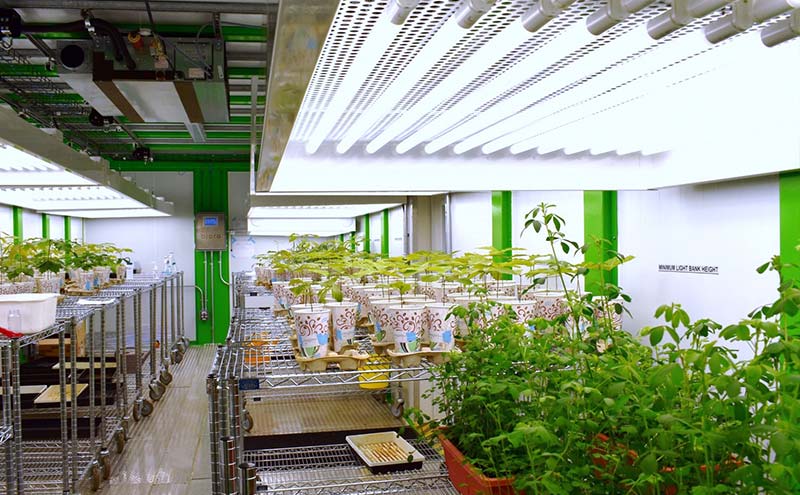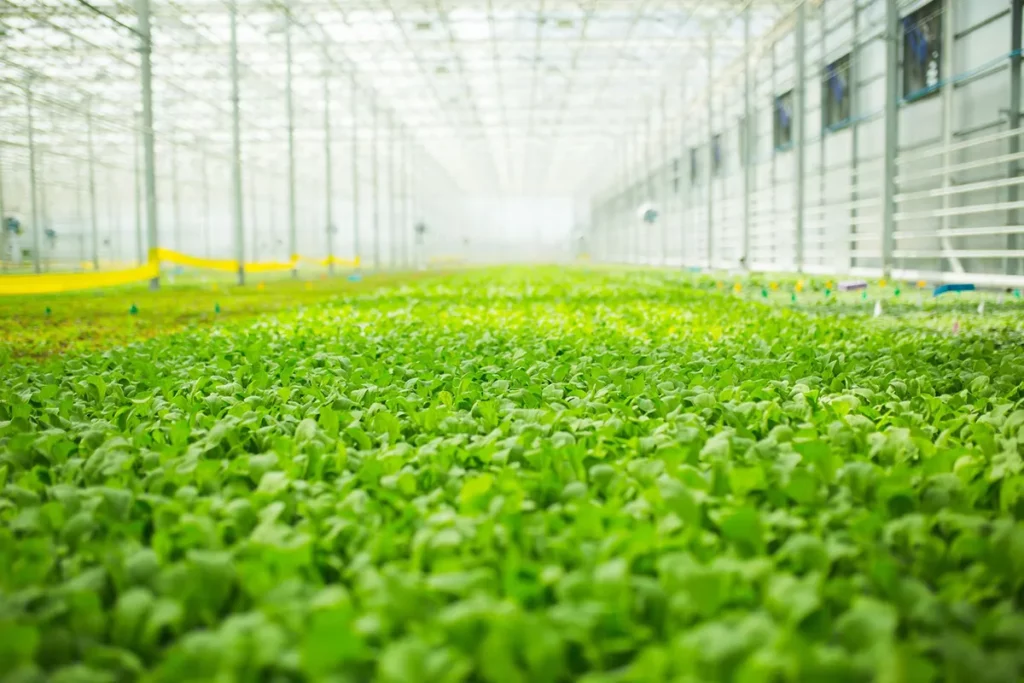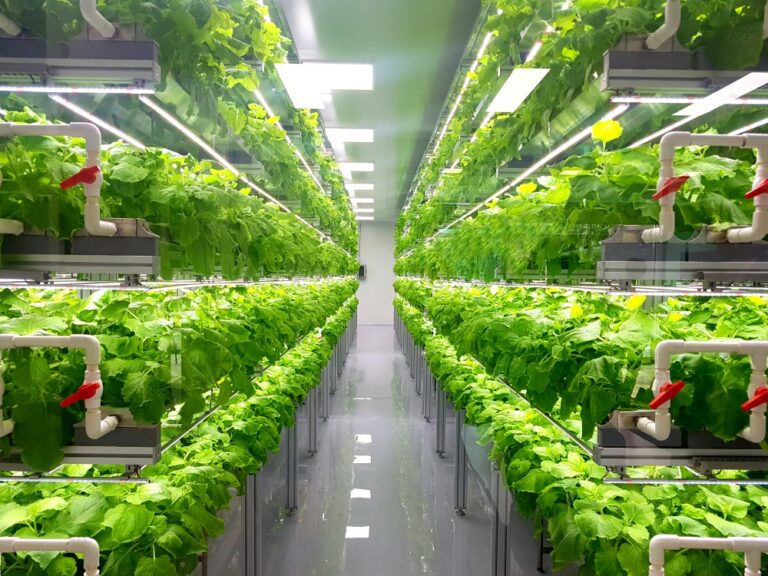Let’s start by comparing the greenhouse and indoor quality with their advantages.
Greenhouse advantages:
- Greenhouses harness natural sunlight, reducing energy consumption and costs.
- They offer a controlled environment for plant growth, extending the growing season.
- Greenhouses can support many plant species and are well-suited for starter plants.
- These structures provide protection against harsh weather conditions and pests.
- They are adaptable to various climates, making them accessible to a wide range of growers.
- Greenhouses can offer a more sustainable approach to agriculture with reduced resource usage.
Indoor quality advantages:
- Indoor environments allow precise control over light, temperature, and humidity, optimizing plant growth.
- They offer consistent year-round conditions, enabling exotic or sensitive plant species to be cultivated.
- Indoor setups are effective at preventing pest infestations and diseases.
- They can be tailored to maximize space, making them ideal for urban farming.
- Indoor environments are well-suited for commercial production, providing predictable yields.
- These setups can reduce water usage through efficient hydroponic or aquaponic systems.
Greenhouse Vs Indoor Quality: Differences Between Greenhouse and Indoor Quality for Plant Growth

When it comes to cultivating plants, two common methods are greenhouses and indoor environments.
Greenhouses provide a controlled environment that mimics natural conditions, while indoor environments rely on artificial lighting and climate control.
The choice between the two depends on various factors such as space availability, cost, and specific plant requirements. Both methods offer unique advantages and challenges for plant cultivation.
Let’s differentiate these two methods for signifying to grow your plant.
Light Source:
Greenhouse: Utilizes natural sunlight, providing varying light intensities throughout the day based on weather conditions, latitude, and season.
Indoor Quality: Deploys artificial lighting systems that offer consistent and controllable light levels, typically measured in micromoles per square meter per second (μmol/m²/s).
This ensures optimal growth conditions regardless of external factors.
Temperature Control:
Greenhouse: Relies on passive solar heating during the day and may require additional heating systems at night. The temperature inside a greenhouse can fluctuate with outdoor weather conditions.
Indoor Quality: Maintains precise temperature control with heating, Cooling, and ventilation systems. Temperatures are maintained within a specific range, typically between 68-77°F (20-25°C).
Humidity Management:
Greenhouse: Humidity levels fluctuate with outdoor weather, which can be challenging for some plants. Relative humidity can range from 40% to 90%.
Indoor Quality: Offers precise humidity control, typically maintaining relative humidity levels between 50% and 70%. This control prevents fungal issues and optimizes plant growth.
Pest and Disease Prevention:
Greenhouse: Provides some protection from pests and diseases compared to outdoor cultivation but may still require integrated pest management (IPM) strategies.
Indoor Quality: Offers superior pest and disease control due to the isolation from external factors, reducing the need for extensive IPM measures.
Energy Consumption:
Greenhouse: Generally, it consumes less energy as it relies on natural light. Energy consumption varies but is typically lower compared to indoor setups.
Indoor Quality: Requires more energy due to artificial lighting, heating, and cooling systems. Energy consumption can vary widely but is often higher than in greenhouses.
Plant Variety:
Greenhouse: Suitable for a wide range of plants, including vegetables and ornamental species, but may not be ideal for sensitive or exotic species.
Indoor Quality: Allows for precise customization of environmental conditions, making it suitable for a wider variety of plants, including rare or delicate species.
Year-Round Cultivation:
Greenhouse: Extends the growing season but may not support year-round cultivation in all climates due to temperature fluctuations.
Indoor Quality: Provides consistent year-round conditions, enabling continuous cultivation regardless of external weather conditions.
Commercial Scale:
Greenhouse: Commonly used for commercial crops like tomatoes, cucumbers, and peppers.
Indoor Quality: Preferred for large-scale commercial production, especially for high-value crops like herbs, leafy greens, and microgreens due to better yield predictability and crop consistency.
These differences highlight the distinct advantages and considerations associated with choosing between a greenhouse and an indoor environment for plant cultivation.
The plant growers should consider these factors to figure out the best approach for their needs and what they have available.
Greenhouse Vs. Indoor Quality: A Table Showing the Differences
Here’s a table summarizing the differences between Greenhouse and Indoor Quality for plant growth:
| Aspect | Greenhouse | Indoor Quality |
|---|---|---|
| Light Source | Utilizes natural sunlight, subject to weather variations. | Employs artificial lighting systems with consistent light levels. |
| Temperature Control | Relies on passive solar heating, leading to temperature fluctuations. | Maintains precise temperature control within a specified range. |
| Humidity Management | Humidity levels vary with outdoor weather conditions. | Offers precise humidity control, typically maintaining 50-70% RH. |
| Pest and Disease Control | Provides better protection than open fields but may still require IPM. | Offers superior control due to isolation, reducing the need for extensive IPM. |
| Energy Consumption | Generally, it consumes less energy due to natural light. | Requires more energy for artificial lighting, heating, and Cooling. |
| Plant Variety | Works well for many plants but might not be great for delicate ones | Allows for precise customization, suitable for various plant types. |
| Year-Round Cultivation | Extends the growing season but may not support year-round cultivation everywhere. | Provides consistent conditions, enabling year-round cultivation. |
| Commercial Scale | Commonly used for commercial production of various crops. | Preferred for high-value commercial crops due to better yield predictability. |
These differences emphasize the distinctions between greenhouses and indoor setups, highlighting their unique advantages and considerations for plant cultivation.
Growers can choose the most suitable approach based on their specific needs and resources.
Greenhouse vs. Indoor Quality: The Similarities
Similarities Between Greenhouse and Indoor Quality for Plant Growth
Controlled Environment:
Both Greenhouse and Indoor Quality: Provide controlled environments that shield plants from external weather conditions, allowing for year-round cultivation.
Protection from Pests and Diseases:
Both Greenhouse and Indoor Quality: Offer superior pest and disease control compared to open-field cultivation, reducing the need for chemical pesticides.
Light Optimization:
Both Greenhouse and Indoor Quality: Allow for precise light management. While greenhouses use natural sunlight, indoor setups use artificial lighting to optimize photosynthesis and growth.
Humidity Regulation:
Both Greenhouse and Indoor Quality: Enable humidity control is crucial for plant health. Maintaining ideal humidity levels prevents stress and fungal issues.
Extended Growing Season:
Both Greenhouse and Indoor Quality: Extend the growing season, allowing for early planting and late harvests, increasing yield potential.
Customization of Growing Conditions:
Both Greenhouse and Indoor Quality: Permit growers to tailor environmental conditions to specific plant requirements, such as temperature, humidity, and light intensity.
Higher Yield Potential:
Both Greenhouse and Indoor Quality Tend to produce higher yields per square meter compared to traditional outdoor cultivation, resulting in increased productivity.
Resource Efficiency:
Both Greenhouse and Indoor Quality Are generally more resource-efficient in terms of water usage compared to open-field farming due to controlled irrigation systems.
These similarities underline the shared benefits of providing a controlled environment for plant cultivation and enhancing plant health, yield, and resource efficiency in both greenhouses and indoor setups.
Growers can leverage these advantages to meet various agricultural goals while minimizing the impact of external factors.
4. Environmental Impact Considerations: Greenhouse vs. indoor quality

When comparing greenhouses and indoor gardening setups in terms of their environmental impact, several key factors come into play:
1. Energy Consumption and Carbon Footprint:
Greenhouses: Greenhouses typically rely on natural sunlight during the day, reducing the need for artificial lighting.
However, they may require supplementary heating and cooling systems, especially in regions with extreme temperatures. The energy consumption of greenhouses can vary widely based on the location and technology used.
Indoor Quality: Indoor gardening setups use artificial lighting, heating, and cooling systems, which can significantly increase energy consumption. The energy source influences the carbon footprint.
For instance, setups powered by renewable energy sources like solar panels can have a lower environmental impact.
2. Pesticides and Fertilizers:
Greenhouses: Greenhouses provide some protection from pests and diseases compared to outdoor cultivation. However, growers may still use pesticides and fertilizers, which can have runoff effects on nearby ecosystems if not managed properly.
Indoor Quality: Indoor environments offer better pest and disease control due to isolation. As a result, the need for pesticides is reduced. Additionally, precise control over nutrient delivery can minimize fertilizer runoff.
3. Sustainable Practices and Technologies:
Greenhouses: Sustainable practices in greenhouses include integrated pest management (IPM) to minimize pesticide use, water-efficient irrigation systems, and the use of energy-efficient technologies like thermal curtains and solar-powered ventilation.
Advanced greenhouse designs can capture and reuse rainwater, further reducing environmental impact.
Indoor Quality: Sustainable indoor gardening practices involve the use of energy-efficient LED grow lights, automated climate control systems, and hydroponic or aeroponic systems that recycle and conserve water and nutrients.
Additionally, growers can utilize organic pest control methods like beneficial insects.
In conclusion, both greenhouses and indoor gardening setups have environmental impacts that can be mitigated through sustainable practices and technologies.
The choice between them should consider factors like energy sources, water management, and the potential use of pesticides and fertilizers.
Ultimately, the environmental impact can vary widely based on growers’ specific setup, location, and practices.
5. Factors to Consider when Choosing between Greenhouse and Indoor Quality
When deciding between a greenhouse and indoor growing for your plants, several important factors must be considered. Each option has its own advantages and disadvantages, and your choice should be based on your specific needs and circumstances.
Lighting Requirements:
Greenhouse: Greenhouses rely on natural sunlight, which is free and abundant during the day. However, the amount of light can vary depending on the location and weather conditions.
Indoor: Indoor growing allows you to have more control over the lighting. You can use artificial lights to provide a consistent and customizable light spectrum and duration.
Temperature Control:
Greenhouse: Greenhouses can be more challenging to control in extreme weather conditions. They tend to get hot during the day and cool down at night.
Indoor: Indoor environments offer precise temperature control, which is crucial for certain plants that require stable temperatures.
Pest and Disease Management:
Greenhouse: Greenhouses are more exposed to outdoor pests and diseases but allow natural predators to thrive and help control pests.
Indoor environments offer better protection against pests and diseases but may require more proactive pest management strategies.
Watering and Humidity:
Greenhouse: Greenhouses can have high humidity levels due to the water used for irrigation and the natural moisture from plants.
Indoor: Indoor settings allow for precise humidity control, which can benefit plants requiring specific humidity levels.
Space and Scalability:
Greenhouse: Greenhouses provide a larger growing area and are suitable for larger-scale operations.
Indoor setups can be smaller and more suitable for limited space, making them ideal for home growers.
Energy Costs:
Greenhouse: Greenhouses rely on natural sunlight, reducing the need for artificial lighting. However, heating or Cooling may be necessary.
Indoor: Indoor setups typically require more lighting and climate control energy, leading to higher operational costs.
Initial Investment:
Greenhouse: Building a greenhouse can be a significant upfront investment, but ongoing maintenance costs are generally lower.
Indoor: Indoor setups may require substantial lighting and climate control equipment investments.
Here are the details about the initial investment and maintenance costs of greenhouse and indoor quality.
Greenhouse:
Initial Investment:
- Small to Medium-Sized Greenhouse: $1,000 to $5,000
- Large Commercial Greenhouse: $10,000 to $100,000 or more
- Maintenance Costs (annually):
- Heating and Cooling: $500 to $5,000
- Repairs and Upkeep: $500 to $2,000
Indoor Growing:
- Initial Investment:
- Small Home Setup: $500 to $1,000
- Intermediate Indoor Setup: $1,000 to $3,000
- Larger, High-End Indoor Setup: $3,000 to $5,000
- Maintenance Costs (annually):
- Electricity (Lighting and Climate Control): $500 to $2,000
- Replacement of Bulbs and Equipment: $100 to $500
An Example of the initial investment and maintenance costs for the greenhouse and indoor growing
Let’s consider an example to illustrate the cost difference between a greenhouse and an indoor setup. Suppose you want to grow tomatoes.
In a greenhouse, you might spend $5,000 on construction and $500 annually for heating and Cooling. In contrast, an indoor setup could cost $2,000 for lighting and climate control equipment, with an annual electricity cost of $1,200.
Over five years, the greenhouse would cost $7,500, while the indoor setup would cost $8,000.
In conclusion, choosing between a greenhouse and indoor growing depends on your specific needs, budget, and the plants you want to grow.
Greenhouses offer natural sunlight and lower energy costs but may have limited temperature control.
Indoor setups provide precise environmental control but come with higher energy costs. Think about these things carefully to make a smart choice for your growing project.
Decision: So, What to choose between a greenhouse and a hothouse?
Choose a greenhouse for versatility and adaptability to a wide range of plants and climates. They utilize natural sunlight and offer a controlled environment that extends the growing season.
Select the hothouse if you specifically need to maintain consistently high temperatures for heat-loving plants, particularly tropical species. Hothouses rely on external heating systems and are less adaptable to varying climates.
Ultimately, pick what’s best for your plants and the environment you have.
FAQs
Is a greenhouse or indoor environment better for plant growth?
It depends on the specific plant and environmental conditions. Greenhouses offer natural light and some climate control, while indoor environments provide full control but may require artificial lighting.
Which environment is more energy-efficient for plant growth?
Indoor environments can be energy-efficient if equipped with LED grow lights and efficient climate control systems. Greenhouses rely more on natural light, potentially reducing energy consumption.
Do greenhouses or indoor setups require more water for plant growth?
It varies depending on environmental conditions and plant types. Greenhouses may require less water due to natural humidity, while indoor environments may need more precise watering.
Which setup is better for year-round plant cultivation?
Both can support year-round growth with the right adjustments. Greenhouses extend growing seasons naturally, while indoor setups offer consistent conditions year-round.
Are there differences in environmental impact between greenhouses and indoor setups?
Yes, there are differences in environmental impact between greenhouses and indoor setups, with greenhouses often having a lower carbon footprint due to their reliance on natural light and fewer energy-intensive systems.
Which is more cost-effective for hobbyist plant growers?
For hobbyists, greenhouses are often more cost-effective initially, as they rely on sunlight. Indoor setups can be expensive due to the need for lighting and climate control systems.
Which environment is better for preventing pests and diseases?
Greenhouses can offer some protection from pests, but indoor environments with controlled access are more effective at preventing infestations and diseases.
Can indoor environments support a wider range of plant species compared to greenhouses?
Yes, indoor environments provide precise control over light, temperature, and humidity, making them suitable for a broader range of plants, including exotic or non-native species.
Which setup requires less maintenance and monitoring?
Greenhouses often require less daily monitoring due to natural light and climate variations. Indoor environments demand more precise monitoring and maintenance.
Which option is more suitable for commercial plant production?
Commercial growers often prefer indoor environments for precise control and predictable yields. However, greenhouses are also used for large-scale production, especially for certain crops.
Conclusion
When considering greenhouse vs. indoor quality for plant growth, it is important to evaluate specific needs and priorities.
Greenhouses offer advantages such as natural light and a controlled environment, while indoor growing provides precise control over conditions.
Sustainability and environmentally conscious practices are vital in both settings. Individuals should assess their goals and resources to make the best choice, considering factors like energy usage and water efficiency.
Ultimately, prioritizing sustainability will lead to more environmentally friendly and efficient plant growth regardless of the chosen option.

